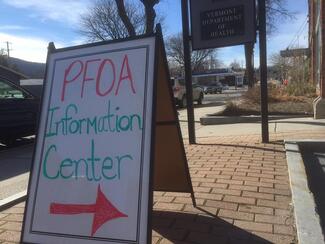
Following news in early 2016 of PFOA-contaminated municipal water wells in Hoosick Falls, New York, and concerns about the former Chemfab property in North Bennington, the Vermont Agency of Natural Resources/Department of Environmental Conservation sampled five private drinking water wells and the North Bennington municipal water supply for perfluorinated compounds and volatile organic compounds. The five private wells tested showed the presence of perfluorooctanic acid (PFOA) at concentrations ranging from 40 to 2,880 parts per trillion. These levels were above the Vermont Department of Health’s drinking water health advisory level at the time, which was 20 parts per trillion. The Department of Environmental Conservation continued to test residential drinking water wells in North Bennington and Bennington.
In February 2016, the Health Department alerted area health care providers, and in April began offering PFOA blood testing for affected residents.
In January 2017, the Health Department presented a summary of the results of its PFOA blood testing and exposure assessment. The study confirmed that drinking water from contaminated wells was the primary source of exposure to PFOA. Read the PFOA blood testing and exposure assessment report.
The State of Vermont's investigation included environmental testing in other areas. Find more information about the testing, public meetings, and related non-health aspects of the state's actions on the Department of Environmental Conservation's website.
